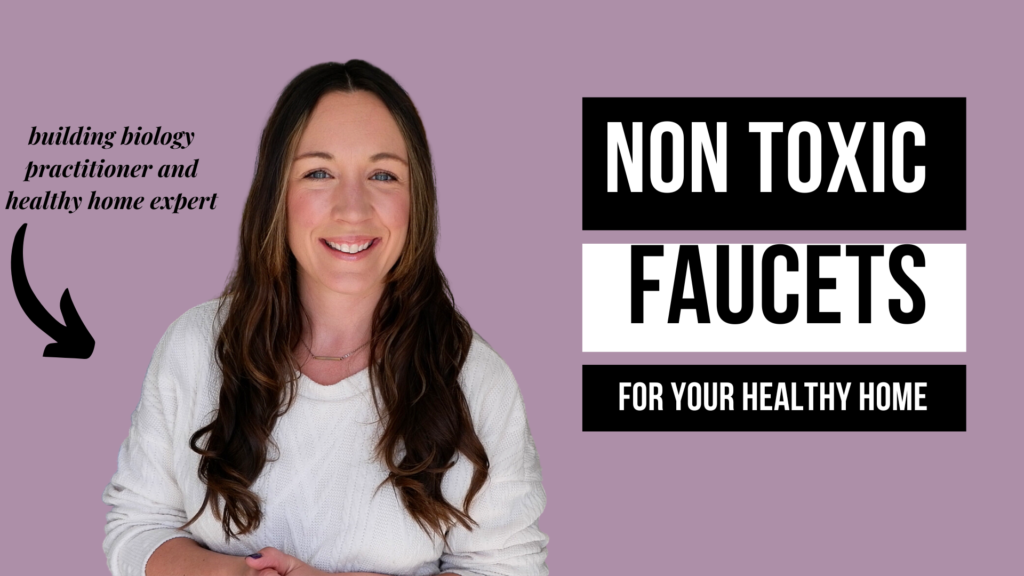
Growing up in a home where my dad was a licensed Master Plumber and my mom worked managing the plumbing business, I learned A LOT about faucets and how to replace them. One of my favorite things when I was really little was going with my dad to help him with his work, even if it was just to hold the flashlight for him. While we didn’t necessarily talk about lead in water back then, he did show me a lot about how to replace a faucet and plumbing in general.
And growing up with this knowledge of how things work has really helped me understand how toxins can be present in not just that faucet you’re replacing, but also in the products you’re using to install the faucet.
It’s given me a unique advantage to understand how different building materials can affect your health and wellness and how other materials probably won’t be of too much concern. Because how we use things in our home plays a HUGE role in how toxic they may be.
And faucets are a big one to pay attention to. Not only are we touching faucet handles, but more importantly, water is coming out of the faucet that can leach toxins into it. And even more importantly, the temperature of the water can be another consideration.
So if you’re in the market for a new faucet, or you just want to know this information for the future, this post will be the one to reference. I’m sharing:
- Toxins in most faucets
- If it’s important to replace your current faucet
- What to look for when you replace a faucet
- How to replace a faucet in a low toxin way
- Healthy house approved faucets

TOXINS IN FAUCETS
I’m guessing most of us worry more about the source of our water and toxins in that and forget about the potential toxins that are inside our faucets. The truth is your water can leach toxins at any point in your home from your own plumbing and fixtures. Here are the big toxins that can be present inside of faucets:
Lead: Many faucets still contain lead. And while the federal regulations limit the amount of lead, there really is no safe amount of lead inside your bodies. Lead builds up in our systems quite quickly as our body doesn’t detox it very well. Children’s lead can quickly escalate to unsafe levels harming their development and cognitive skills.
Pathogens: Bacteria, viruses and pathogens can live on surfaces in and around the faucet, causing them to contaminate the water you’re washing your hands with or drinking. Certain waterway materials are more conducive to bacteria than others.
PVC Toxins: Polyvinyl chloride is used in fittings and pipes and certain components within a faucet. PVC does have the ability to leach toxins into your water when hot water is used or if the material is newer.
SHOULD I REPLACE MY FAUCET RIGHT AWAY?
As with so much of what we discuss here at Healthy House on the Block, there really is no black and white answer to this question. To determine if you should replace a faucet, you would need to take into consideration a few different things.
First, is this faucet used for drinking water out of? If it were me, I’d want to know that the spot I was drinking water from was completely toxin free. This is the most important thing to consider. So if you’re unsure if your kitchen sink faucet is lead free and you use your sink to wash food or use it to cook with, it might be worth considering a faucet replacement.
A bathroom faucet is one of those faucets that you potentially could leave if you’re unsure about the lead within the faucet. If you need to brush your teeth or rinse your mouth out with that particular faucet, you can bring filtered water in a cup to the bathroom with you while you wait to replace the faucet.
And finally, a shower faucet is one to consider replacing. Sometimes you can get an add on shower head that will filter out some of the water before spraying out. And so if it’s something you don’t plan to replace for a while, you can certainly go this route of filtering the water rather than replacing the faucet.

WHAT TO LOOK FOR WHEN YOU REPLACE YOUR FAUCET
When you’re on the hunt for replacement faucet, there are some key terms to know and some key things to look for:
Waterway material is referring to the material that is directly around the water and directly touching the water as it flows from your pipes to the spout of the faucet. THIS material is what matters the most when we’re looking at a healthy, toxin free faucet. So pay attention to what the waterway material is made of.
100% Lead free is the most important thing to look for. Beware of faucets that say “lead free” as they can still contain .25% of lead in the material. A faucet that is advertised as 100% lead free is the real deal.
Certifications like the NSF/ANSI/CAN 61 certification can indicate that there are very low levels of lead in the faucet as they meet the approved requirements for leaching. You can look for the NSF mark on the package of the faucet to ensure that it follows these requirements.
Stainless steel is the BEST material you can find for a replacement faucet and it’s the least toxic option for your home. A faucet that contains brass or brass waterways is one that likely has lead, as brass and lead usually go hand in hand. Lead free brass is not only uncommon, but very difficult to find.

HOW TO REPLACE A FAUCET IN A LOW TOXIN WAY
You may have guessed, but there are more materials and products involved in replacing a faucet than the faucet itself. You want to make sure that materials you’re using are also free from toxins and especially lead.
Whether you’re going to hire a plumber or do the project yourself, you can ask that particular materials be used. And better yet, you can provide them for the professional. Below are some of the common building materials you might use when you’re replacing a faucet in your home:
Lead free solder: Eastman Sterling Lead Free Solder
Plumber’s Putty: Oatey Sta Put Ultra
Thread Seal Tape: Blue Monster
Caulking: Chemlink

HEALTHY HOUSE APPROVED FAUCETS
Remember, it may not be necessary to rip out perfectly good faucets. BUT, when the time comes and you’re ready to make the change, why not do it in a low toxin way to prevent new toxins from entering your space. Afterall, a healthy home will support your health and wellness rather than burden it down.

Share this:
- Click to share on Facebook (Opens in new window) Facebook
- Click to share on LinkedIn (Opens in new window) LinkedIn
- Click to share on Reddit (Opens in new window) Reddit
- Click to share on Pinterest (Opens in new window) Pinterest
- Click to print (Opens in new window) Print
- Click to share on X (Opens in new window) X







Dear Amanda,
We did communicate by email once before and I did reread the column and reviewed the recommended toxin free faucet companies.
I would like to purchase a Parmir faucet. I tried to reach the company by phone twice. I did leave a voice message. I also sent emails.
My concern is I haven’t heard back from them. My plumber reviewed the information concerning the faucets. He said that it looked like a very good product. The concern is if I can’t connect with now. What happens, if I should find a way to buy one, and there is a problem?
I called two other companies you recommended and received customer assistance immediately.
Is there something I may be overlooking?
I’d appreciate your advice.
Thank you!
Lynn
I am having a hard time finding all stainless steel faucets. Do you have some brands you know are trustworthy in their all stainless steel claims? I found a company called Trustainless but they seem a little “off” to me? few reviews on Amazon, and not on Trustpilot.com at all? Would you please recommend some companies and have you ever heard of Trustainless? Thank you.
hi! any specific bathroom sink faucets you would reccomend? i’m having trouble finding anything that fits into your guidelines. Kraus says they use “lead free brass waterways” – not sure if this fits into your category of needing it to say 100% lead free. thanks!
Thanks for the information. The info on building materials involved in faucet installation is such a great addition to the topic!
One thing I am confused about is lead free vs 100% lead free. Krauss has faucets listed with titles that include “100 % lead free” but the company has explained that such faucets “meet AB1953 requirements” ( The California Assembly Bill 1953 which defined “lead-free” to mean not more than a 0.25% weighted average) which means it can have “up to 0.25% lead by weight.”
Pingback: PFAS In Water and How to Remove Forever Chemicals